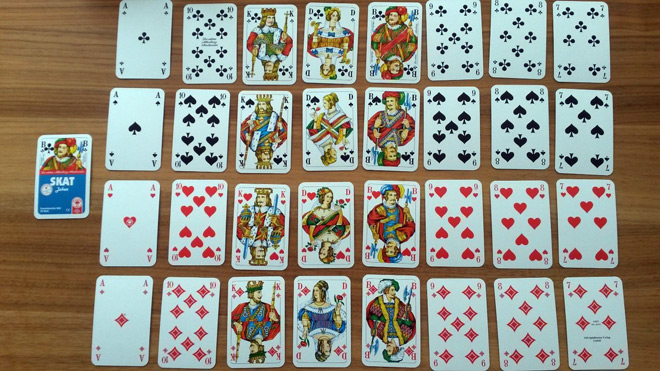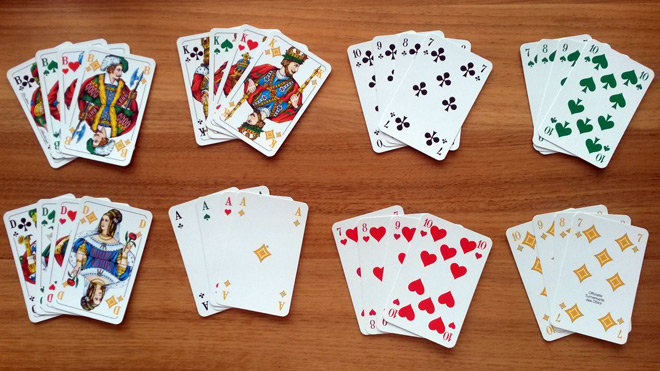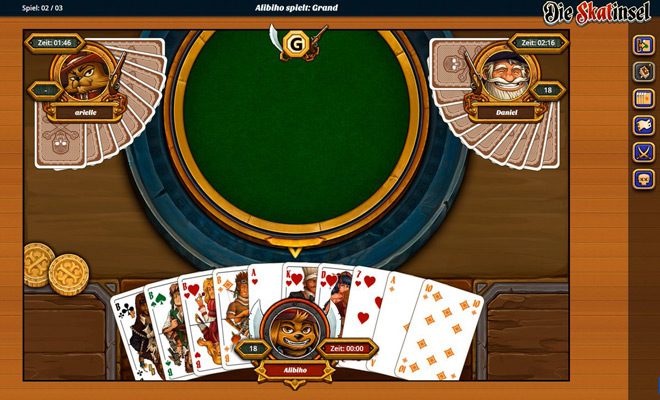The complete Skat rules
Learning the rules of a game can be fun if they’re presented in a simple and interesting manner – as we’ve done here. The rules of Skat are explained step by step. If that’s too dry for you, maybe you should try our interactive teaching site.
The Deck
Skat is played with a 32-card deck. There are four suits: Diamonds, Hearts, Spades and Clubs. Each suit consists of eight cards: 7, 8, 9, 10, Jack, Queen, King, Ace. In the English deck, the Jack, Queen, King and Ace are represented by the letters J, Q, K, A. Most Skat players use a slightly different deck (called a French deck) where the Jack is called “Bube” (boy) and is represented by the letter B, and the Queen is called “Dame” and is represented by the letter D. This is easy to remember: B = Boy = Jack and D = Dame = Q. Here’s what the French deck looks like:

Additionally, in some regions a “German” deck is used, which has distinctive graphics and two face cards with different names: the Queen is called “Ober” and the Jack “Unter”.
A few years ago an official Skat tournament deck was introduced which has a separate color for each suit: Clubs = black, Spades = green, Hearts = red, Diamonds = orange.

On the Skat Island site you can choose which deck you want to use. As part of our campaign to attract new players, a special feature even lets you to design your own deck.

Starting the Game
Skat is played by three players. If there are four players at the table, one player deals and then sits out for that hand. This player sometimes kibitzes, looking at the cards of one, but not both, of the other players.
After shuffling, the dealer distributes the cards, face down, in a set pattern: three cards to each player, then two cards in the middle (the Skat), then four cards to each player and finally three cards to each player. Now each player has 10 cards in his hand and 2 are in the Skat. Who gets to pick up the Skat is determined by the next step, the bidding.
If you play online you don’t have to worry about any of this. The Skat Island software shuffles, deals, facilitates the bidding and keeps score for you, allowing you to concentrate on your hand.
How the Game is Played
In Skat, one player, called the declarer, plays against the other two, who act as a team. Who becomes the declarer is determined by the bidding. To win a game, the declarer must take more than half of the 120 points in the deck, that is, 61 or more. You need a good hand to do this so you have to be careful in the bidding.
Each game takes only about 2 or 3 minutes. But like a good action film, a lot can happen in this short time: suspense, bluffs, twists and turns, and the outcome uncertain until the end.
After each game the cards are shuffled and dealt again. This time your old enemy may become your new partner.
The Course of the Game
After you pick up your cards you need to evaluate your hand to gauge if it’s strong enough for you to become the declarer. If so, you should enter the bidding, if not, you should pass. The winning bidder gets to pick up the Skat, giving him 12 cards. Then he has to put any 2 cards back into the Skat, which still belongs to him. This is called “burying” and is an art unto itself. Which cards you bury depends on your hand as a whole and your plan for winning your game.
In this instructional video you’ll be given a valuable tip about burying. You’ll learn how narrow the gap is between winning and losing, and how important it is to bury the right cards.
After burying, the next step is declaring the game to be played. Here there are three basic types of games: Suit game, Null, or Grand.
After these preliminaries, we’re now at the central element: playing the cards. The player to the left of the dealer, called “forehand”, leads the first card. Then each player adds a card, playing in clockwise order, and must play a card of the suit led if possible. The highest card wins the trick. The winner of a trick gathers it in, turns it face down, and leads to the next trick.
After all 10 tricks are played, the points are added up to see which side has won. The points taken by the two defenders are added together, and the declarer’s points are counted separately and include any points in the Skat. In online Skat the program automatically adds the points and announces the winner.
Bidding, also called the Auction
This process, which rings in each game, can be puzzling to new players. The calculations look complex and the system of bidding and holding may seem obscure.
It’s really not so difficult but like so many things is a matter of practice. You’ll soon grasp the essential calculations. So let’s look a little more deeply at the details.
The bidding is nothing more than an auction where the highest bid wins. But because each player doesn’t know the strength of his hand relative to the other players, they usually don’t jump in with their highest bid but haggle to win the auction as cheaply as possible.
DThe bids are calculated by multiplying a “basic value” of the type of game you intend to play (the basic values are: Diamonds = 9, Hearts = 10, Spades = 11, Clubs = 12, Null = 23, and Grand = 24) by a number which represents which of the top trump cards you hold. The lowest bid is normally 18, for a Diamond game with a Tops value of 1. The highest possible bid is 264, which, however, almost never occurs.
You can remember who bids to whom by the following saying: Deal, Listen, Talk, Talk some more.
Declaring the Game: Grand, Null or Suit
There are three different types of games in Skat. This makes learning somewhat more complicated but in the long run guarantees variety and suspense. Each game type has its own rules, strategies and appeal.
In Grand, only the four Jacks are trump. Their order relative to each other is determined by their suit. The Club Jack is the strongest, followed by the Spade, Heart and Diamond Jacks. The remaining suits are of equal value and their cards are ordered: Ace, 10, King, Queen, 9, 8. 7.
In Suit games, the four Jacks become part of the trump suit. The Jacks, maintaining their internal order, are the strongest trumps, followed by the trump Ace, 10, King, Queen, 9, 8, 7. The order of the cards in the non-trump suits remains the same.
Finally, in Null, all of what you’ve just learned in thrown out the window. In Null, the declarer wins by not taking a single trick. There are no trump cards and the order of the cards is a little different: Ace, King, Queen, Jack, 10, 9, 8, 7 - just as in most other card games.
Rules understood? Then we can move on.
If you’ve got these rules down, you should take a look at some valuable tips in the strategy section. Then you can try your first game. At the Skat Island site not only can you learn how to play but you can also play for free at our game portal: play Online Skat for free.
